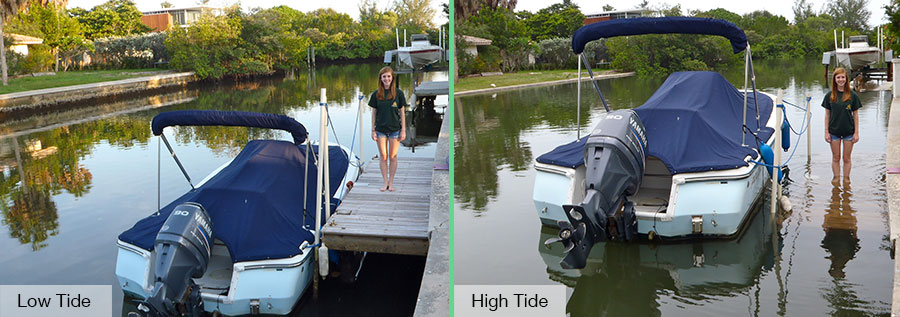A new study now underway at the University of South Florida, with funding from the National Science Foundation and the U.S. Environmental Protection Agency, aims to answer that question. The first phase, which focuses on interviews with the scientists who see the day-to-day changes and follow international reports in great detail, is nearly complete.
The second phase kicks off in October with two events: Thursday, October 24 from 6:30-8:30pm at Weedon Island Preserve Cultural and Natural History Center (registration website: http://climateweedon.eventbrite.org) and Saturday, October 26 from 2:00-4:00pm at St. Petersburg College-Tarpon Spring Campus (registration website: http://climatetarpon.eventbrite.org).
The interactive programs will encourage residents to review the various scenarios and share their insights with the USF team, including anthropologists, biologists and geologists.
“What we’re doing is building a series of scenarios that are storyline-based and highly visual so that people can look at them and tell us what they think,” said Gina Larsen, a USF anthropologist working with Rebecca Zarger, the principal investigator for the study. “We’ll combine the data from the Intergovernmental Panel on Climate Change (IPCC) and the information we’ve gathered locally to talk about the risk and vulnerabilities in the Tampa Bay region specifically.”
The scenarios will be updated using insights gained through those meetings, and surveys will be finalized and available both online and as part of scheduled in-person interviews with key stakeholders.
“It’s a combination of asking people what they think is going to happen and educating them at the same time,” Larsen said. “They’ll have the opportunity to look at the scenarios and then help create the future they want.”
The results of the study will be shared with planners, policy makers and elected officials when it is complete.
[easy-media med=”391″ size=”450,159″ align=”right” style=”transparent”]Climate change, she adds, is already happening. “It’s not a question of when or if, it’s a question of how extreme it will be. We’ve passed the point of preventing climate change; we’re looking at ways to mitigate it and minimize the impact.”In fact, sea level rise over the past years has consistently exceeded the predictions made by scientists. “The last time it was this warm was 125,000 years ago. There was no continental ice in Greenland or Antarctica, and the Lake Wales Ridge was the only part of Florida still above water,” said Mark Rains, a USF hydrogeologist working on the study.
[su_pullquote align=”right”]King tides, which occur once or twice a year when the orbits of the earth and moon come into alignment, are the highest predictable tides. The Tampa Bay and Sarasota Bay Estuary Programs are sponsoring a travelling photo exhibit to raise awareness of the impact of rising sea levels.[/su_pullquote]“There’s a lag between the time that temperatures rise and glaciers melt – and still a lot of uncertainty about the rate at which sea level will rise – but Florida is going to look very different over the next 50 to 100 years.”Although the research was originally intended to focus on water quality and quantity, it has expanded to look at impacts as diverse as development on barrier islands and inland agricultural operations. Even in the best-case scenario, barrier islands will flood more frequently and residents will be forced to relocate to areas further inland.
Since populations – and land values – are concentrated on the coastline, it will leave a large number of people who need to find new homes, as well as a significant challenge for local governments. For instance, someone who is forced to leave a condo on Clearwater Beach may move to a similar home in a higher location in Pinellas County – or they may choose to move to Orlando instead.
And while exact data is difficult to come by, clearly the most expensive homes in Tampa Bay are on the water, where they are most vulnerable to sea level rise.
From the perspective of agricultural operations, saltwater intrusion (as higher sea levels push saltwater further into aquifers) is likely but there is still a great deal of debate about rainfall in Tampa Bay and across Florida, Larsen said. “There’s no consensus on rainfall patterns except that they will be dramatically changed. We’ll either get a lot more rain, or a lot less, and we’re likely to see a loss of seasonality so we won’t have the wet-summer, dry-winter pattern we’re accustomed to.”
While not enough water would clearly impact the region’s growth and economic sustainability, too much water could create higher volumes of stormwater, carrying contaminants from landscapes and agriculture into Tampa Bay and damaging those ecosystems, she added.
“We don’t know all the answers and we’re not all on the same page, but we need to have more voices heard and more people involved in mitigating the impact so we’re all better off as a community, Larsen said. “If we start the conversation about climate change now, we’ll be able to create partnerships that help mitigate the impacts.”
[su_box style=’info’ title=’Learn more’]- The USF study focuses on impacts to humans and man-made infrastructure, but the Tampa Bay Estuary Program recently completed a comprehensive report on the effect of climate change on ecosystems. It’s online here.
- The Tampa Bay Regional Planning Council also completed a comprehensive report on the impacts of climate change, available at http://www.tbrpc.org/mapping/sea_level_rise.shtml
- Nearly 1,000 scientists around the world are working as part of the Intergovernmental Panel on Climate Change (IPCC) to track climate change. Visit http://www.ipcc.ch/ for more information.
Upcoming exhibits include:
- South Florida Museum (Bradenton): September – October
- Sarasota Bay Water Festival (Sarasota): November 2
- Weedon Island Preserve (St. Petersburg) : November 4 – 30
- Robinson Preserve (Bradenton) : January – February 2014
- Oldsmar Public Library – April 2014
- St. Petersburg Main Library – May 2014
FINAL MAPS
- Hillsborough County (6MB PDF file)
- Pinellas County PDF (9MB PDF file)
